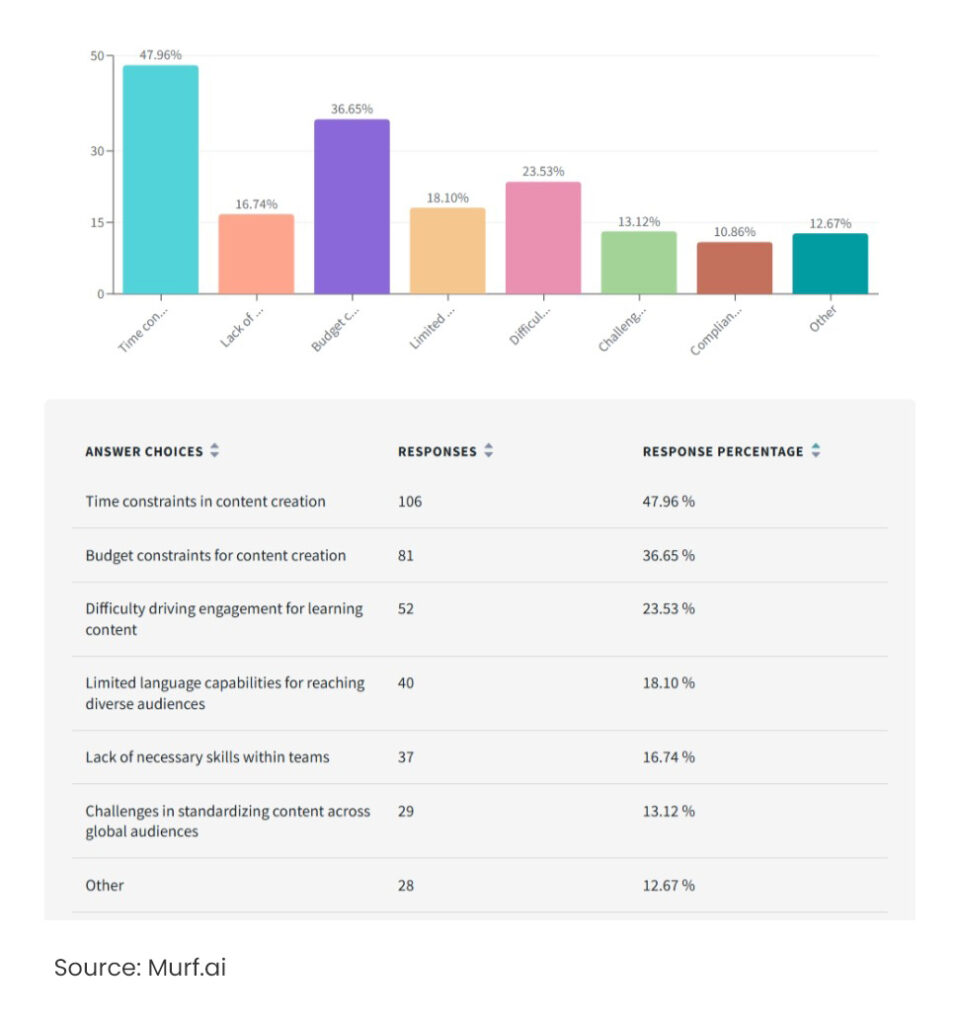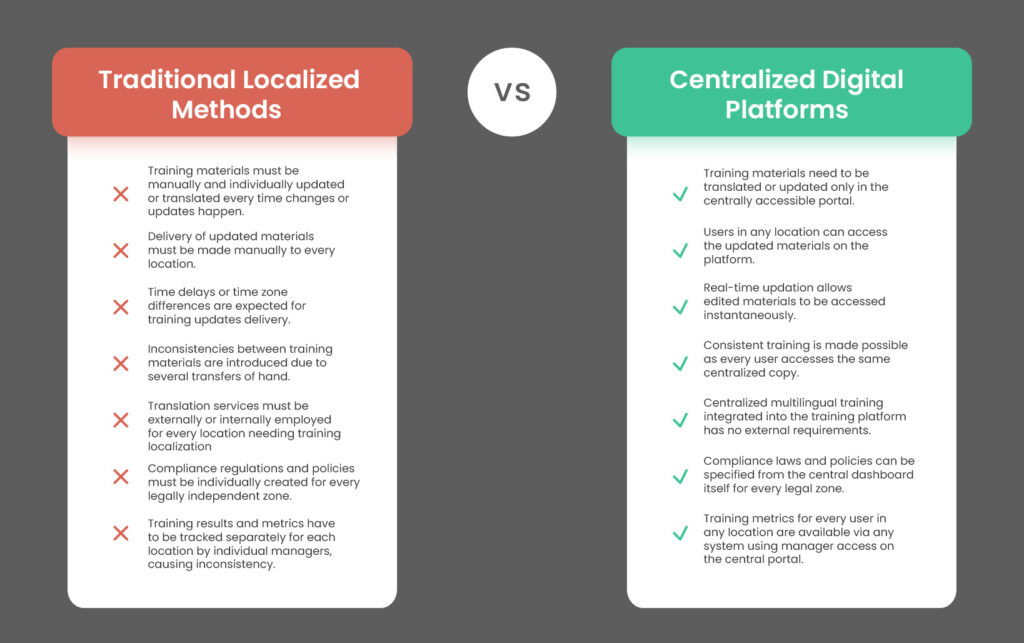Introduction

These challenges will always translate to the responsibility of maintaining and updating content too, especially if it is for training a global workforce. Shortcomings in the training material maintenance process, especially when there are several versions in different languages, can lead to quality inconsistency, information accuracy issues, accessibility problems, and more. Training no longer remains homogenous across teams, leading to employee disengagement, irregular employee performance, errors, helpdesk calls, etc. What you need is a scalable, centralized multilingual training solution like Assima. Our innovative systems training solution utilizes simulation training with integrated multilingual functionalities that help you conquer these issues by bypassing human constraints and making training a delight for employees and content creators alike.
Explore the amazing capabilities of Assima in taking multilingual enterprise training to the next level.
The Challenge of Multilingual Training at Scale
Most global companies maintain region-specific training independently. Each office location or group of bases in a region maintains its own training program, with lessons in native languages and integrating local compliance requirements. They implement updates and translations in their own way and time, exclusive of how other offices are doing it. This throws up several problems like:
- Inconsistencies in training due to content being outdated in locations where updates are delayed or irregular
- Lack of homogeneity between the same lessons in different locations due to being maintained by different teams
- Compliance and regulatory issues in which some locations fall behind in training employees in time for changes
- Inability for employees from different locations to collaborate smoothly due to differences in their knowledge from training
- Excess cost, time, and resource wastage, often culminating in failure, during attempts at training consolidation
However, training synchronization across regions can be challenging, even for global enterprises with sufficient resources. Here are a few real-life examples of issues you might face:
- If your operations are spread across a very large network, often, by the time you have assessed and suggested improvements in the training in a fraction of your locations, the next round of training updates have to start. This makes the whole exercise till then, futile.
- Different locations could use different languages for training. This adds several extra steps like translation, language accuracy review, and more, to the synchronization process.
- Compliance regulations also differ from one location to another. Extra caution is necessary when reviewing and updating compliance training.
- Training synchronization becomes especially tough in situations where different offices use different software versions and workflows.
Why Lesson Language Management Matters in Global Training Programs
Multilingual training content management is extremely important to ensure smooth functioning in operations that span multiple office locations. Inconsistent training leads to differences in business processes, leading to friction when collaboration is required between teams in different locations. Businesses end up wasting time and resources trying to find a solution that seamlessly connects operations across locations.
This situation transforms from a hassle to a liability in regulated industries where tight operational rules and regulations apply to businesses. Incompatible training systems lead to conflicting knowledge about processes and security. The consequent variability in business methods could lead to non-compliance, which sets up the possibility of lawsuits. This is an outcome no company wishes to face.
Beyond the legal repercussions, the loss in productivity due to a lack of regional training consistency can also be significant. Resources and working hours spent on getting up to speed about mutual processes and conventions and adapting to them could have been spent on getting actual work done. It reduces efficiency, creates missed deadlines, increases support tickets, and introduces communication gaps that take time to resolve. The situation becomes much worse with language barriers, which adds another communicative difference, multiplying the problems. You will end up needing translation services on top of the existing problem. Without centralized multilingual training, global enterprises will inevitably face hardships in maintaining optimization in business procedures across centers.
Traditional Solutions vs. Centralized Training Platforms
Digital adoption analytics are essential in measuring the effectiveness of enterprise learning in a large and/or distributed workforce. The benefits you gain include:

This makes it clear just how inefficient traditional siloed systems are – they consume too much time and resources but fail to deliver proportional results. With a centralized multilingual training system, you can edit, update, maintain, and translate any lesson at any time, with the changes being reflected in every copy of the lesson.
Localization is essential for providing global training according to regional requirements. Here’s how Assima helps.
How Assima Train Solves Multilingual Lesson Management and Localization Challenges
Assima takes advantage of its 4X patented cloning technology to streamline training content localization for every lesson created on the platform. Let’s take a look at the features that make this possible:
Centralized Simulation Content Management
Assima utilizes a centralized training platform for creating and maintaining lessons. Any simulation or lesson created using Assima is uploaded to Assima Cloud, from where anyone with clearance can access it. Any modifications needed in the lessons just need to be done in this central copy of the simulation, and it would be reflected in every copy of the lesson accessed from anywhere by any authorized user using any terminal.
Localization-Ready Infrastructure
Assima’s proprietary simulation authoring technology allows streamlined training translation management of all its lessons. As long as the right translation dictionary is uploaded to the system, you can translate the lessons to any permitted language. This applies to the data, instructions, and interface of the simulations as well as the platform. Once the basic lesson template is created, you do not need to re-record system processes to translate them.
Real-Time Sync Across Regions
Assima’s global centralized multilingual training management system ensures that not only are updates and changes automatically reflected on every copy of a lesson, but they also become visible in real time. While many global training solutions allow centralized storage and access of content, a surprising majority require manual syncing. However, you can forgo the multiple rounds of updation and QA with Assima.
Consistent Employee Experience Across Borders
Consistency in training is the key to ensuring consistency in performance. Often, due to differing languages, compliance rules, or software versions, it becomes difficult to manage lesson copies with the same level of quality control. Assima Train localization, on the other hand, is unique. You can define different rules and utilize different languages, but the quality and accuracy of the content in every lesson remains the same, ensuring consistent employee experience.
Benefits of Centralized, Multilingual Training with Assima
Centralized multilingual training is essential for enterprises operating on a global level. The right approach can ensure many benefits like:
Faster Go-to-Market Training Enablement
When you don’t utilize centralized multilingual training, you have to spend time and manpower on translations and modifications every time a new language, lesson, or update is introduced. With Assima, the only significant task is to create the lesson and upload the necessary translation dictionaries. The translation is a single action after that. As a result, training can be deployed much faster.
Cost Reduction from Duplicated Translation Efforts
Often, excessive resources are expended in multilingual employee training due to duplicated efforts – you have to make the same translation repeatedly for different lesson copies. However, translation using Assima is a single-step action that can be done as many times as you want from the base lesson template without needing to be re-recorded. You do not need continued translation services.
Risk Reduction from Outdated Content
Often, with bulky workflows for updating, maintaining, and translating training content, quality control goes down the drain. Many offices end up training with outdated copies of the lesson longer than recommended due to delays in training updation and keep working based on that inaccurate knowledge, resulting in inefficiency.
Better Performance from Aligned, Localized Training
When the training content, quality, and process are consistent and aligned to industry standards across all your offices, your teams are bound to perform well across all locations. Moreover, collaboration between teams at different locations would be smooth, ensuring that the overall productivity of the company is also boosted.
Real-World Example: Assima and Plan International
Plan International, an international children’s charity, was migrating to SAP to replace three legacy systems operated locally at 275 locations in 53 countries. They needed a training system that was fast, cost-effective, and consistent, as they needed training in English, French, and Spanish. They turned to Assima to make it happen. Not only did Assima help provide strong SAP multilingual training support, but it also maintained quality and homogeneity across all languages and locations. The interactive training methods ensured confident, skilled end-users who kept their operations running smoothly after the migration. Read the whole story here.
Best Practices for Managing Global Training at Scale
Using a centralized multilingual training solution aside, you must also implement the principles of centralized training to make the program a success.
Build Training with Localization from the Start
If you make localization a core part of your training process, you will not have to worry about the hassle of incorporating it later on. Setting up training with localization features and procedures integrated ensures results par expectations from the start.
Use Modular Simulation-Based Training
Simulation-based training, as provided by Assima, is far easier to deal with for multilingual control as well as for training quality. On one side, you get scenario-based learning which boosts retention, and on the other, the modular nature of simulations makes maintenance easier.
Track Content Lifecycle Across Regions
Ensure that when you conduct quality control for training content or implement a modification to the material, it is made accessible to all applicable users at all locations. Keep track of their status across the content lifecycle to maintain the expected level of consistency.
Utilize a Scalable Training Solution
Understand that businesses, especially global ones, can grow rapidly, establishing bases in new locations in no time. Always employ a scalable training solution that can grow along with it so the new offices get the same quality of training as the rest.

Conclusion
Global-scale multilingual training demands strict and efficient quality control to ensure consistency in training across sites, without which it would be impossible to implement seamless operations on a worldwide scale. This can only be implemented using a robust centralized multilingual training solution like Assima. Its innovative cloning technology and centralized cloud access make training a distributed workforce easier than ever. Assima has been built for scale, consistency, and easy localization. It is ideal for enterprises operating globally across multiple linguistic and legal zones.
Ready to simplify your global training efforts? Try Assima Train today.
Frequently Asked Questions
Let’s Answer Some of Your Questions.
Multilingual training requires consistency in the factual meaning of the training materials even when translated. Any edits or updates must be accurately translated into all the different lesson copies. Without this, errors and differences would crop up in the lessons, causing employees in different locations to have differing knowledge.
Assima has built-in multilingual capabilities and supports every language used in the corporate world. Lessons can be translated from a single source without the need to re-record. This makes managing training in multiple languages easy and efficient.
Inconsistent training causes lower productivity and inefficiency, block collaboration efforts, increase errors and helpdesk calls, slow down operations, cause compliance breaches, and encourage confusion and low morale among employees.
Yes, any changes made in an Assima clone are reflected in real-time across every lesson copy, including translated ones. You do not have to manually enter changes in each copy.
Assima allows the localization of compliance regulations and policies. Based on the compliance requirements of a region and access rules of individual employees, training and information access can be tailored to prevent any security breaches.
